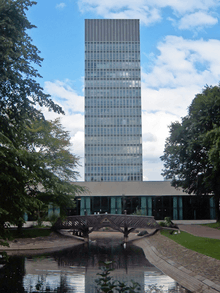Arts Tower
- For the skyscraper in Panama City, see Arts Tower (Panama City)
| Arts Tower | |
|---|---|
|
Arts Tower in 2013 | |
| Record height | |
| Tallest in Sheffield from 1965 to 2010[I] | |
| Preceded by | Sheffield Town Hall |
| Surpassed by | St Pauls Tower |
| General information | |
| Type | University |
| Location | University of Sheffield, Sheffield, United Kingdom |
| Coordinates | 53°22′58″N 1°29′14″W / 53.382738°N 1.487289°WCoordinates: 53°22′58″N 1°29′14″W / 53.382738°N 1.487289°W |
| Construction started | 1963 |
| Completed | 1965 |
| Opening | 1965 |
| Owner | University of Sheffield |
| Height | |
| Roof | 78 m (256 ft) |
| Top floor | 78 m (256 ft) |
| Technical details | |
| Floor count | 20 |
The Arts Tower is a building at 12 Bolsover Street in Sheffield, England belonging to the University of Sheffield and opened in 1966. English Heritage has called it "the most elegant university tower block in Britain of its period".[1] At 255 feet (78 m) tall, it is the second tallest building in the city, after the 101 m, St Paul's Tower on Arundel Gate, which was topped out in 2009.[2] It is also the tallest university building in the United Kingdom.[3]
Designed by architects Gollins, Melvin, Ward & Partners, construction of the tower started in 1961 and lasted four years. Contrary to popular belief, there is no documentary evidence to suggest that the design was directly inspired by the similar, but much larger, Seagram Building in New York City, similarly to the popularly believed, though unsubstantiated, theory regarding the CIS Tower and New Century House in Manchester, England - although the similarity of aesthetics between the four buildings is undeniable. When asked about the possible inspiration of Mies van der Rohe's buildings in the United States, GMW project architect Robert Smith explained instead that the form of the building came from the surrounding context.[4]
Entry to the building was originally made by a wide 'bridge' between fountains over a shallow pool area in front of the building. This pool was eventually drained and covered over when it was found that strong down drafts of wind hitting the building on gusty days caused the fountain to soak people entering and exiting the building. An alternative design for a Rotunda-style cylindrical building was thrown out when suitable curved furnishings were costed.

The building was officially opened by Queen Elizabeth, The Queen Mother in June 1966;[5] it has 20 stories and a mezzanine level above ground. These housed the Departments of Landscape, Modern Languages, Philosophy, Biblical Studies, and Architecture as well as the library administration, before the building's refurbishment. As its name suggests, the building originally housed all the University's arts departments, which had far fewer students in the 1960s. Noticeboards for long rehoused departments such as History and Social Science survive in the basement foyer area. There are also two floors below ground level that house nine lecture theatres. The building contains a cafe in the basement.[6] It has a student computer room on the 10th floor,[7] and a self-service language teaching centre on the second.[8] Circulation is through two ordinary lifts and a paternoster lift which, at 38 cars, is the largest of the few surviving in the United Kingdom.[9]
A bridge at the mezzanine level links the tower to Western Bank Library. This building was also designed by Gollins, Melvin, Ward & Partners—the two buildings are intended to be viewed together.[10] The Arts Tower and Library are Grade II* listed buildings.[11]
The buildings can be visited during office hours, although visitors may have to sign a register and show identification.[12]
In December 2007, the University announced plans for a major refurbishment of the Arts Tower. The refurbishment saw a major re-organisation of the building's interior, as well as a new façade, and coincided with the move of the modern languages departments to the Jessop West building, on the former Jessop Hospital site. The building was vacated in April 2009, with refurbishment taking approximately two years to complete.[13] The work was finished in time for the beginning of the 2011-12 academic year; the building is still used for teaching, with the top nine floors allocated to the University's School of Architecture and Departments of Landscape.
References and notes
- ↑ Multimillion pound revamp for city structure - Sheffield Star 6 February 2008
- ↑ World Architecture News
- ↑ http://www.emporis.com/en/bu/sk/st/tp/ty/ed/. Accessed 29 January 2007
- ↑ Schneider, Tatjana (2008). This Building Should Have Some Sort of Distinctive Shape: The Story of the Arts Tower in Sheffield. University of Sheffield. ISBN 978-0-9556669-0-2.
- ↑ Mathers, H. (2005) Steel City Scholars, The Centenary History of the University of Sheffield, p191. James and James (Publishers) Ltd. ISBN 1-904022-01-4
- ↑ School of Architecture Course Handbook 2007 - 2008 Archived 16 July 2011 at the Wayback Machine.
- ↑ Student Computer Rooms
- ↑ Facilities Archived 26 June 2007 at the Wayback Machine.
- ↑ PatList
- ↑ Harman, R. & Minnis, J. (2004) Pevsner City Guides: Sheffield, pp82–84. New Haven & London: Yale University Press. ISBN 0-300-10585-1
- ↑ Historic England (1993). "Library and Arts Tower, University of Sheffield (457011)". Images of England. Retrieved 7 January 2006.(registration required)
- ↑ Using the Library
- ↑ The Arts Tower Archived 11 March 2012 at the Wayback Machine.

